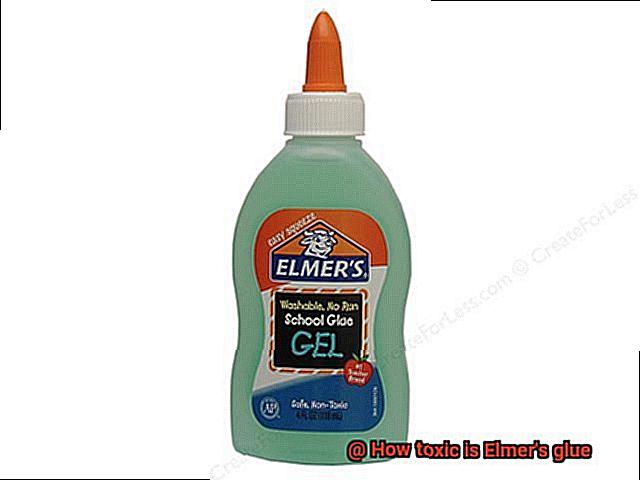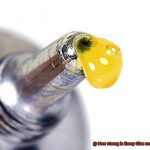Picture this: You’re knee-deep in an arts and crafts project, memories of childhood creativity flooding back as you reach for that familiar bottle of glue. And there it is, the iconic Elmer’s glue, a trusted companion in all things sticky. But have you ever stopped to wonder just how toxic this seemingly harmless adhesive really is?
Well, wonder no more. In this blog post, we’re diving headfirst into the world of Elmer’s glue to unravel the truth about its potential toxicity. But hold on tight, because we’re not here to scare you with exaggerated tales. Oh no. We’re all about providing the facts and giving you a balanced perspective.

So grab a seat and get ready as we dig deep into scientific research, dissect the composition of Elmer’s glue, and shine a light on any potential risks associated with its use. Whether you’re a concerned parent wanting to ensure your child’s craft supplies are safe or an avid DIY enthusiast eager to learn more, our mission is to arm you with the knowledge needed to make informed decisions when it comes to using Elmer’s glue.
So go ahead, brew yourself a cup of coffee (or tea if that’s more your style), get cozy, and join us on this journey as we uncover the truth behind Elmer’s glue toxicity once and for all.
What is Elmer’s Glue?
Contents
In the world of arts and crafts, finding the perfect adhesive is like uncovering a hidden treasure. Look no further than Elmer’s Glue, a legendary name that has stood the test of time. With its iconic white color and thick, sticky texture, Elmer’s Glue has become an essential tool in the crafting universe. In this article, we will embark on a journey to unravel the wonders of Elmer’s Glue – what it is, its composition, and its astonishing versatility. So grab your imagination and let’s dive into the enchanting world of Elmer’s Glue.
Composition:

Elmer’s Glue is a captivating blend of water and polyvinyl acetate (PVA), an extraordinary synthetic polymer. PVA, a marvel of modern science, is not only safe but also non-toxic, ensuring peace of mind during your creative escapades. However, let us remember that Elmer’s Glue is meant for external use only and should never be consumed.
Versatile Uses:
- Arts and Crafts: Elmer’s Glue is the enchanting adhesive that ignites artistic brilliance. Its water-soluble nature allows for effortless cleanup while wet, making it a dream come true for various applications. From creating mesmerizing collages to fashioning intricate papercrafts or embarking on daring DIY projects, Elmer’s Glue bonds with unwavering strength once dry.
- School Projects: Every classroom harbors a secret weapon – Elmer’s Glue. It weaves magic in the hands of students as they construct captivating dioramas or unleash their imagination through homemade slime concoctions. With Elmer’s Glue, their ideas soar to new heights.
- Household Repairs: Beyond its artistic prowess, Elmer’s Glue unveils a hidden talent in the realm of household repairs. It mends broken ceramics, reinforces wobbly furniture joints, and breathes new life into weakened wooden surfaces. Elmer’s Glue is the knight in shining armor that restores order to your cherished possessions.
Specialized Options:
Elmer’s Glue offers an enchanting array of specialized options, each with its own unique charm:
- Clear Glue: When invisibility is paramount, Elmer’s Clear Glue casts a spell of transparency, ensuring a seamless finish to your projects.
- Glitter Glue: For those who seek a touch of sparkle in their creations, Elmer’s Glitter Glue combines the adhesive prowess of Elmer’s with the shimmering allure of glitter, transforming ordinary crafts into dazzling masterpieces.
Availability:
The magic of Elmer’s Glue is accessible to all. It can be found in a multitude of sizes, from dainty bottles for personal use to mighty containers for industrial feats. Explore the aisles of craft stores or venture into general retailers, where the wonders of Elmer’s await your beckoning call.
Main Ingredient in Elmer’s Glue
Elmer’s Glue, the beloved adhesive that has captured the hearts of artists and crafters, has a secret ingredient that makes it so special. The main ingredient in Elmer’s Glue is polyvinyl acetate (PVA), a synthetic polymer derived from petroleum.
PVA is more than just a fancy term – it’s a substance with remarkable properties. First and foremost, it’s non-toxic and non-hazardous, ensuring your safety during all your creative endeavors. No need to worry about harmful chemicals when you’re using Elmer’s Glue.
One of the standout features of PVA glue is its water-based formula. This means that you can easily clean up any mess with just plain old water. Say goodbye to harsh solvents and chemicals – a quick rinse is all it takes. This makes Elmer’s Glue perfect for children’s crafts and projects, where messes are bound to happen.
But the real magic of PVA glue lies in its bonding abilities. When PVA glue dries, it forms a strong and flexible bond, capable of sticking together a wide range of materials like paper, wood, fabric, and more. Whether you’re creating a collage masterpiece or repairing a broken chair leg, Elmer’s Glue has got your back.
While PVA glue itself is safe, it’s important to note that some Elmer’s glue products may contain additional ingredients that could be potentially harmful if ingested or used improperly. These additives might include preservatives or performance-enhancing chemicals like formaldehyde or ammonia. To ensure safe and proper use, always read the label and follow the instructions provided by the manufacturer.
Is Elmer’s Glue Toxic?
If you’re a devoted crafter or someone who loves getting their hands dirty with DIY projects, chances are you’ve crossed paths with Elmer’s Glue. But have you ever wondered if this beloved adhesive is actually safe to use? Fear not, my fellow creators, because I’m here to give you the lowdown.
Elmer’s Glue is primarily composed of polyvinyl acetate (PVA), a synthetic polymer that is considered non-toxic and safe for both children and adults. PVA has undergone rigorous safety testing and has gained approval from regulatory agencies like the U.S. Food and Drug Administration (FDA). So, breathe easy knowing that when used as instructed, Elmer’s Glue poses no harm if it comes into contact with your skin, eyes, or mouth.
However, it’s worth noting that while Elmer’s Glue itself is non-toxic, certain formulations may contain additional ingredients that could be potentially hazardous if misused or ingested. Take Elmer’s Carpenter’s Wood Glue, for instance, which contains formaldehyde. In large quantities, this compound can be irritating and harmful if ingested or inhaled. Hence, always read the label and adhere to the instructions provided on the packaging.
Moreover, keep in mind that some individuals may develop an allergic reaction to Elmer’s Glue. If you experience redness, itching, swelling, or a rash after using the glue, discontinue its use and seek medical attention if necessary.
To ensure your safety when working with Elmer’s Glue, it’s wise to use it in a well-ventilated area and minimize exposure to its fumes. By taking these precautions, you can minimize potential risks and enjoy your crafting endeavors without worry.
Certification of Non-Toxicity
When it comes to arts and crafts, safety is paramount, especially when children are involved. Elmer’s glue, a trusted brand in the industry, has gone above and beyond to earn its certification as non-toxic. In this article, we will delve into the rigorous testing and standards that Elmer’s glue adheres to, providing you with the peace of mind you need for your creative projects.
Certifications from ACMI and ASTM:
Elmer’s glue has achieved its non-toxic status through certifications from renowned regulatory bodies such as the Art and Creative Materials Institute (ACMI) and the American Society for Testing and Materials (ASTM). These organizations subject products to stringent tests that ensure they meet the highest standards of non-toxicity. As a testament to its commitment to safety, Elmer’s glue proudly displays the ACMI’s AP seal, signifying that it has been independently tested and approved as a non-toxic product.
Compliance with CPSIA:
Elmer’s glue goes one step further by complying with the requirements of the Consumer Product Safety Improvement Act (CPSIA). This act specifically regulates consumer product safety, with a particular emphasis on products used by children. To meet these stringent safety standards, Elmer’s glue has undergone extensive testing to ensure it contains no toxic substances such as lead and phthalates.
Usage Considerations:
While Elmer’s glue has been certified as non-toxic, it is important to exercise caution when using any art or craft materials. Remember to read and follow the instructions and warnings provided by the manufacturer. Although Elmer’s glue is safe when used as directed, it should not be ingested or inhaled in large quantities.
Potential Adverse Effects:
Despite its low levels of toxicity, accidental ingestion of Elmer’s glue can still lead to adverse effects such as nausea, vomiting, and gastrointestinal irritation. If ingestion occurs, immediate medical attention should be sought. It is crucial to keep Elmer’s glue out of the reach of young children to prevent any accidents.
Potential Risks of Ingesting or Inhaling Elmer’s Glue
Before you embark on your next crafting adventure, let’s delve into the lurking dangers beneath the surface.
Potential Risks of Ingesting Elmer’s Glue:

- Gastrointestinal Issues: Consuming Elmer’s glue can lead to gastrointestinal problems, including nausea, vomiting, and stomach pain. Moreover, its adhesive nature can cause blockages in the digestive system when consumed in large quantities.
- Digestive Tract Obstructions: The chemicals in Elmer’s glue can be resistant to the body’s digestive enzymes, resulting in the glue adhering to the walls of the digestive tract. This poses a serious risk of obstructions.
Potential Risks of Inhaling Elmer’s Glue:
- Respiratory Irritation: Inhaling Elmer’s glue fumes can irritate the respiratory system, leading to symptoms like coughing, wheezing, and shortness of breath. Prolonged exposure may cause more severe respiratory issues.
- Allergic Reactions: Some individuals may be sensitive to the chemicals in Elmer’s glue, experiencing allergic reactions upon ingestion or inhalation. These reactions range from mild symptoms like skin rashes or itching to severe anaphylactic reactions requiring immediate medical attention.
Other Important Points:
- Skin Irritation: While Elmer’s glue is generally safe for use on the skin, prolonged or repeated exposure may cause skin irritation or allergies in susceptible individuals. It is advisable to wash off any glue residue after use.
- Stronger Glues: Other types of glue, such as superglue or epoxy, can be even more hazardous due to their stronger chemical compositions. Ingesting or inhaling these glues can cause burns, tissue damage, and severe respiratory distress.
Allergic Reactions to Elmer’s Glue
Elmer’s glue, a beloved companion in classrooms and creative endeavors for generations, boasts its reliability and ease of use. However, even in the realm of this seemingly innocuous adhesive, the possibility of allergic reactions looms. In this comprehensive exploration, we delve into the intricacies of potential allergic reactions to Elmer’s glue and equip you with essential knowledge on prevention.
Skin Irritations:
Amongst the diverse array of allergic reactions to Elmer’s glue, skin irritations take center stage. The telltale signs—redness, itching, and rashes—serve as poignant reminders that not all bodies may embrace this adhesive with open arms. Often triggered by allergies to preservatives or additives nestled within the glue, these symptoms warrant attention. To prevent skin irritations, consider the following:
- Patch Test: Embark on a 24-hour journey of discovery by applying a small amount of Elmer’s glue to your forearm. If no reaction occurs, proceed with peace of mind.
- Read the Label: Unveil the secrets encapsulated within the product label and ingredient list. Vigilantly scout for ingredients that your body deems hostile.
Respiratory Symptoms:
In rare instances, Elmer’s glue may exude a hidden potency capable of provoking respiratory symptoms like an unruly cough or breathlessness. If such afflictions besiege you after employing this adhesive, immediate medical advice shall be your guiding beacon.
Anaphylaxis:
Although resembling an elusive specter, anaphylaxis lurks within the shadows of allergic reactions to Elmer’s glue. This severe manifestation demands unwavering vigilance, as its consequences may prove dire. Exhibiting symptoms such as constricted airways, accelerated heartbeat, and vertigo, anaphylaxis necessitates urgent medical intervention.
Prevention Tips:
To safeguard against allergic reactions to Elmer’s glue, we present two practical tenets:
- Choose Hypoallergenic Products: If your body hoards a treasure trove of allergies or sensitivities, seek out alternative adhesive products that proudly boast their hypoallergenic nature or suitability for sensitive skin.
- Discontinue Use: Should the specter of an allergic reaction rear its head, promptly cease using Elmer’s glue and embark on a journey towards medical counsel. Prudence is the guardian of wellbeing.
Different Formulations of Elmer’s Glue
Elmer’s glue, the beloved crafting companion, offers a world of possibilities with its various formulations. Let’s explore the enchanting realm of Elmer’s glue and discover the diverse options that await.
First and foremost, we have the classic white glue. This non-toxic formulation is a staple for both young and seasoned crafters. Its water-based nature ensures easy cleanup, making it perfect for school projects and artsy endeavors. Squeeze, stick, and behold the wonders you create.
For those seeking an invisible touch, Elmer’s transparent glue is your go-to choice. This formulation dries clear, allowing your projects to shine without any visible adhesive marks. Like its white counterpart, it is non-toxic and safe for all ages.
But wait, there’s more. Elmer’s extends its glue empire beyond the ordinary. The glitter glue takes center stage, adding a touch of sparkle to your crafts and making them truly dazzling. And for those craving convenience, the school glue sticks offer a mess-free application experience. Twist, apply, and stick with utmost ease.
Now let’s delve into Elmer’s glues designed for specific materials or applications. For fabric enthusiasts, Elmer’s presents a textile-specific glue that bonds fabrics with unwavering strength, enduring even the harshest wash cycles. Woodworkers can rely on Elmer’s wood glue, forged to create durable bonds that stand the test of time. And if ceramics are your muse, fear not. Elmer’s offers a glue specially formulated for your ceramic creations.
But what about heavy-duty projects? Fear not, for Elmer’s has got you covered. Their wood glue and epoxy adhesive rise to the challenge, providing formidable bonds for those projects that demand extra strength. Whether you’re constructing furniture or mending household items, these formulations ensure steadfast reliability.
Remember to consult labels and instructions when selecting an Elmer’s glue formulation for your project. While most are non-toxic, it’s prudent to work in well-ventilated spaces and avoid ingestion or inhalation of fumes.
Also Read: Is Elmer’s Glue Toxic?
Conclusion
In conclusion, Elmer’s glue is a safe and non-toxic choice for your arts and crafts projects. The star ingredient, polyvinyl acetate (PVA), is a synthetic polymer that has undergone rigorous safety testing and received the stamp of approval from regulatory agencies like the FDA. This water-based wonder is not only easy to clean up with just water but also gentle on your skin, eyes, and mouth.
However, it’s important to be aware that certain variations of Elmer’s glue may contain additional ingredients that could pose potential risks if used improperly or ingested. Take, for example, the Carpenter’s Wood Glue which may contain formaldehyde. While this chemical can be irritating and harmful in large quantities, there’s no need to worry when using Elmer’s glue as directed.
It’s worth noting that some individuals may develop allergic reactions to Elmer’s glue. If you experience redness, itching, swelling, or a rash after using the glue, it’s best to discontinue use and seek medical attention if necessary.
To ensure safe and proper usage of Elmer’s glue, always consult the label and follow the manufacturer’s instructions. Opt for a well-ventilated area when working with this adhesive genius to minimize exposure to any fumes. And don’t forget to keep it out of reach from curious little hands to prevent any accidents.
Overall, with its versatility and wide range of formulations available, Elmer’s glue remains an unwavering ally in all your creative endeavors.






